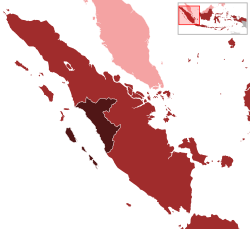
Back Pendudukan Sumatera Barat oleh Jepang ID Sumatra Bârâ' èjajah bi' Jeppang MAD Kadudukan Sumatera Barat dek Japang MIN Pendudukan Jepun di Sumatera Barat Malay
West Coast Province of Sumatra スマトラ西海岸州 (Japanese) | |||||||||||
|---|---|---|---|---|---|---|---|---|---|---|---|
| 1942–1945 | |||||||||||
| Motto: 八紘一宇 (Hakkō Ichiu) ("Eight Crown Cords, One Roof") | |||||||||||
| Anthem: 君が代 (Kimigayo) ("His Imperial Majesty's Reign") | |||||||||||
 West Coast Sumatra (dark red) within the Japanese occupation of the Dutch East Indies (red) | |||||||||||
| Status | Province under military occupation by the Empire of Japan | ||||||||||
| Capital and largest city | Padang[1] 1°00′S 100°30′E / 1.000°S 100.500°E | ||||||||||
| Common languages |
| ||||||||||
| Emperor | |||||||||||
• 1942–1945 | Hirohito | ||||||||||
| Army Commander (Gunshireikan) | |||||||||||
• 1942 | Tomoyuki Yamashita | ||||||||||
• 1942‒1943 | Yaheita Saito | ||||||||||
• 1943‒1945 | Moritake Tanabe | ||||||||||
| Governor (Shūchōkan) | |||||||||||
• 1942‒1944 | Yano Kenzo | ||||||||||
• 1944‒1945 | Hattori Naoaki | ||||||||||
| Legislature | Shū Sangi-kai | ||||||||||
| Kerukunan Minangkabau | |||||||||||
| Historical era | World War II | ||||||||||
• Pacific War begins | 8 December 1941a | ||||||||||
| 14 February 1942 | |||||||||||
| 8 March 1942 | |||||||||||
• Japanese troops land on Padang | 17 March 1942 | ||||||||||
• Japanese Civil Administration set up | 9 August 1942 | ||||||||||
• Disestablished | 17 August 1945 | ||||||||||
| 10 October 1945 | |||||||||||
| Currency | Netherlands Indian roepiah | ||||||||||
| Time zone | UTC+9 (TST) | ||||||||||
| |||||||||||
| Today part of | Indonesia | ||||||||||
| |||||||||||
The Japanese occupation of West Sumatra, officially known as Sumatora Nishi Kaigan Shū (Japanese: スマトラ西海岸州, Hepburn: Sumatora Nishikaigan-shū, lit. 'West Coast Province of Sumatra'),[2][3] started from 1942 until 1945 when the region was controlled by the Empire of Japan. The occupation was notable and recognized as one of the rare instances where a civilian government was established, rather than being governed by someone associated with the Japanese Imperial Army. The Japanese entered Padang on 17 March 1942 and within ten days all important cities in the West Sumatra region were occupied without resistance from the Dutch. The Japanese occupation of the region ended on 17 August 1945 with the proclamation of Indonesian independence by Sukarno and Mohammad Hatta.
In the early days of the Japanese occupation, events in Padang were heavily influenced by Sukarno.[4] In October 1943, Japan ordered the establishment of the Giyūgun to help with defence. Led by Chatib Sulaiman, the Giyūgun was the only army unit formed by the Japanese in West Sumatra. This voluntary army would later become the backbone of Indonesia's armed forces after independence.
- ^ Hata 2001, pp. 138.
- ^ Mansoer et al. 1970, pp. 207.
- ^ Asnan 2007.
- ^ Kahin 2005, pp. 137.

